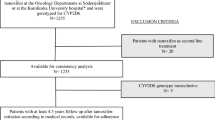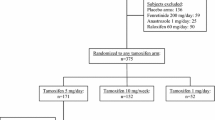Abstract
Concurrent use of tamoxifen and cytochrome P450 2D6 (CYP2D6) inhibitors, such as selective serotonin reuptake inhibitors, has been shown to decrease plasma concentrations of tamoxifen metabolites. However, it is still unclear whether such concurrent use affects tamoxifen’s effectiveness. Thus, the objective of this study is to determine whether concurrent use of tamoxifen with CYP2D6 inhibitors increases the risk of recurrence in patients newly diagnosed with breast cancer. We conducted a nested case–control analysis within a population-based cohort from the UK General Practice Research Database. The cohort included women with a first-ever diagnosis of breast cancer who were prescribed tamoxifen between January 1, 1998 and June 30, 2008. Cases consisted of all patients with a breast cancer recurrence occurring during follow-up. Up to ten controls were matched to each case on year of birth, date of cohort entry, and duration of follow-up. Conditional logistic regression was used to estimate rate ratios (RR) of breast cancer recurrence in patients who concurrently used tamoxifen with CYP2D6 inhibitors, compared to patients who only used tamoxifen. The cohort included 9,209 incident users of tamoxifen, of whom 807 were diagnosed with a breast cancer recurrence. Concurrent use was not associated with an increased incidence of breast cancer recurrence (adjusted RR 1.07, 95% 0.88, 1.30). Type and strength of CYP2D6 inhibitors, as well as duration of concurrent use did not affect breast cancer recurrence. These results remained consistent after performing sensitivity analyses. The results of this large population-based study indicate that concurrent use of tamoxifen with CYP2D6 inhibitors does not increase the risk of recurrence.

Similar content being viewed by others
References
Early Breast Cancer Trialists’ Collaborative Group (EBCTCG) (2005) Effects of chemotherapy and hormonal therapy for early breast cancer on recurrence and 15-year survival: an overview of the randomised trials. Lancet 365:1687–1717
Perez EA (2007) Safety profiles of tamoxifen and the aromatase inhibitors in adjuvant therapy of hormone-responsive early breast cancer. Ann Oncol 18(Suppl 8):viii26–viii35
Jordan VC (2007) New insights into the metabolism of tamoxifen and its role in the treatment and prevention of breast cancer. Steroids 72:829–842
Ingelman-Sundberg M (2005) Genetic polymorphisms of cytochrome P450 2D6 (CYP2D6): clinical consequences, evolutionary aspects and functional diversity. Pharmacogenomics J 5:6–13
Seruga B, Amir E (2010) Cytochrome P450 2D6 and outcomes of adjuvant tamoxifen therapy: results of a meta-analysis. Breast Cancer Res Treat 122:609–617
Lacy C, Armstrong L, Goldman M, Lance L (2007) Cytochrome P450 enzymes: substrates, inhibitors, and inducers. In: Lacy C, Armstrong L, Goldman M, Lance L (eds) Drug information handbook, 15th edn. LexiComp Inc., Hudson, pp 1899–1912
Stearns V, Johnson MD, Rae JM, Morocho A, Novielli A, Bhargava P et al (2003) Active tamoxifen metabolite plasma concentrations after coadministration of tamoxifen and the selective serotonin reuptake inhibitor paroxetine. J Natl Cancer Inst 95:1758–1764
Jin Y, Desta Z, Stearns V, Ward B, Ho H, Lee KH et al (2005) CYP2D6 genotype, antidepressant use, and tamoxifen metabolism during adjuvant breast cancer treatment. J Natl Cancer Inst 97:30–39
Lehmann D, Nelsen J, Ramanath V, Newman N, Duggan D, Smith A (2004) Lack of attenuation in the antitumor effect of tamoxifen by chronic CYP isoform inhibition. J Clin Pharmacol 44:861–865
Goetz MP, Knox SK, Suman VJ, Rae JM, Safgren SL, Ames MM et al (2007) The impact of cytochrome P450 2D6 metabolism in women receiving adjuvant tamoxifen. Breast Cancer Res Treat 101:113–121
Lash TL, Pedersen L, Cronin-Fenton D, Ahern TP, Rosenberg CL, Lunetta KL et al (2008) Tamoxifen’s protection against breast cancer recurrence is not reduced by concurrent use of the SSRI citalopram. Br J Cancer 99:616–621
Chubak J, Buist DS, Boudreau DM, Rossing MA, Lumley T, Weiss NS (2008) Breast cancer recurrence risk in relation to antidepressant use after diagnosis. Breast Cancer Res Treat 112:123–132
Ahern TP, Pedersen L, Cronin-Fenton DP, Sorensen HT, Lash TL (2009) No increase in breast cancer recurrence with concurrent use of tamoxifen and some CYP2D6-inhibiting medications. Cancer Epidemiol Biomarkers Prev 18:2562–2564
Lash TL, Cronin-Fenton D, Ahern TP, Rosenberg CL, Lunetta KL, Silliman RA et al (2010) Breast cancer recurrence risk related to concurrent use of SSRI antidepressants and tamoxifen. Acta Oncol 49:305–312
Dezentje VO, van Blijderveen NJ, Gelderblom H, Putter H, Van Herk-Sukel MP, Casparie MK et al (2010) Effect of concomitant CYP2D6 inhibitor use and tamoxifen adherence on breast cancer recurrence in early-stage breast cancer. J Clin Oncol 28:2423–2429
Siegelmann-Daniel N, Kurnik D, Lomnicky Y, Vesterman-Landes J, Katzir I, Bialik M et al. (2010) Potent CYP2D6 inhibiting drugs do not increase relapse rate in early breast cancer patients treated with adjuvant tamoxifen. Breast Cancer Res Treat. doi: 10.1007/s10549-010-1008-7
Holzman D (2009) Tamoxifen, antidepressants, and CYP2D6: the conundrum continues. J Natl Cancer Inst 101:1370–1371
Walley T, Mantgani A (1997) The UK General Practice Research Database. Lancet 350:1097–1099
Garcia Rodriguez LA, Perez GS (1998) Use of the UK General Practice Research Database for pharmacoepidemiology. Br J Clin Pharmacol 45:419–425
Jick H, Jick SS, Derby LE (1991) Validation of information recorded on general practitioner based computerised data resource in the United Kingdom. BMJ 302:766–768
Lawrenson R, Williams T, Farmer R (1999) Clinical information for research; the use of general practice databases. J Public Health Med 21:299–304
Lawrenson R, Todd JC, Leydon GM, Williams TJ, Farmer RD (2000) Validation of the diagnosis of venous thromboembolism in general practice database studies. Br J Clin Pharmacol 49:591–596
Jick SS, Kaye JA, Vasilakis-Scaramozza C, Garcia Rodriguez LA, Ruigomez A, Meier CR et al (2003) Validity of the general practice research database. Pharmacotherapy 23:686–689
Suissa S (2005) Novel approaches to pharmacoepidemiology study design and statistical analysis. In: Strom B (ed) pharmacoepidemiology, 4th edn. John Wiley & Sons, Chichester England, pp 811–829
Essebag V, Platt RW, Abrahamowicz M, Pilote L (2005) Comparison of nested case-control and survival analysis methodologies for analysis of time-dependent exposure. BMC Med Res Methodol 5:5
Essebag V, Genest J Jr, Suissa S, Pilote L (2003) The nested case-control study in cardiology. Am Heart J 146:581–590
de Vos D, Slee PH, Stevenson D, Briggs RJ (1992) Serum elimination half-life of tamoxifen and its metabolites in patients with advanced breast cancer. Cancer Chemother Pharmacol 31:76–78
Brewster DH, Thomson CS, Hole DJ, Black RJ, Stroner PL, Gillis CR (2001) Relation between socioeconomic status and tumour stage in patients with breast, colorectal, ovarian, and lung cancer: results from four national, population based studies. BMJ 322:830–831
Carroll DG, Kelley KW (2009) Use of antidepressants for management of hot flashes. Pharmacotherapy 29:1357–1374
Kelly CM, Juurlink DN, Gomes T, Duong-Hua M, Pritchard KI, Austin PC et al (2010) Selective serotonin reuptake inhibitors and breast cancer mortality in women receiving tamoxifen: a population based cohort study. BMJ 340:c693
Decensi A, Robertson C, Viale G, Pigatto F, Johansson H, Kisanga ER et al (2003) A randomized trial of low-dose tamoxifen on breast cancer proliferation and blood estrogenic biomarkers. J Natl Cancer Inst 95:779–790
Kisanga ER, Gjerde J, Guerrieri-Gonzaga A, Pigatto F, Pesci-Feltri A, Robertson C et al (2004) Tamoxifen and metabolite concentrations in serum and breast cancer tissue during three dose regimens in a randomized preoperative trial. Clin Cancer Res 10:2336–2343
Lash TL, Lien EA, Sorensen HT, Hamilton-Dutoit S (2009) Genotype-guided tamoxifen therapy: time to pause for reflection? Lancet Oncol 10:825–833
Huiart L, Dell’Aniello S, Suissa S (2009) Patterns of use of tamoxifen and aromatase inhibitors: a population-based observational study. J Clin Oncol 27:556
Acknowledgments
Dr. Laurent Azoulay is the recipient of a ‘Chercheur-Boursier’ Award from the Fonds de la recherche en santé du Québec. Dr. Samy Suissa is the recipient of a Distinguished Investigator Award from the Canadian Institutes of Health Research. This study was supported by the Canadian Institutes of Health Research and Canada Foundation for Innovation.
Conflicts of interest
The authors have no conflicts of interest to declare.
Author information
Authors and Affiliations
Corresponding author
Appendix
Rights and permissions
About this article
Cite this article
Azoulay, L., Dell’Aniello, S., Huiart, L. et al. Concurrent use of tamoxifen with CYP2D6 inhibitors and the risk of breast cancer recurrence. Breast Cancer Res Treat 126, 695–703 (2011). https://doi.org/10.1007/s10549-010-1162-y
Received:
Accepted:
Published:
Issue Date:
DOI: https://doi.org/10.1007/s10549-010-1162-y




